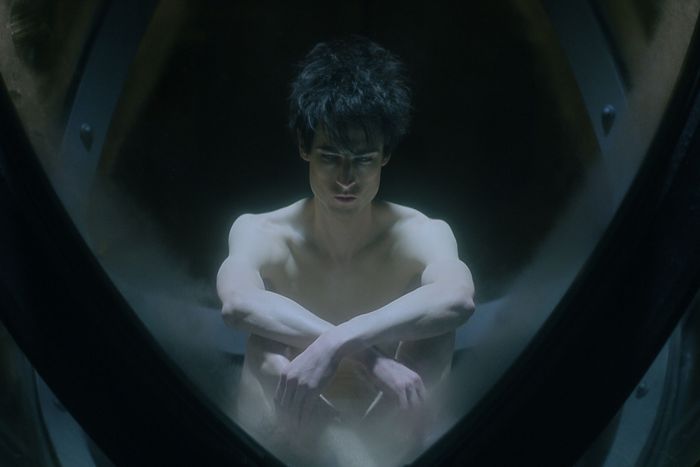
Neither sweet dream nor horrifying nightmare, Netflix’s The Sandman, the long-gestating adaptation of Neil Gaiman’s legendary DC Comics series, is more of an afternoon nap, the kind that unintentionally whiles away an afternoon: initially pleasant, but then it just … keeps going. After the season’s visually ambitious and ominously tense first half, the pacing slows and the narrative flow stagnates until you feel like you just woke up on the couch with bleary eyes, a fuzzy mouth, and the rest of The Sandman already half-forgotten. Dream of the Endless (Tom Sturridge) may offer “freedom and adventure” to his mortal visitors, but The Sandman doesn’t entirely hold up its end of the bargain. That reneged promise is tied primarily to the series’ treatment of Dream, who goes by many names over these ten episodes — Morpheus, the Oneiromancer, and of course, the titular Sandman — but never seems fully fleshed out. And without a strong sense of Dream and his motivations, all the stories and characters revolving around him suffer, too.
Adaptation is difficult, and there’s no way that every element of The Sandman could be mapped exactly onto a TV show, even considering Gaiman’s involvement as a series co-creator, executive producer, and writer. The mediums are different, and so are their methods. (And now that there is an established DC Extended Universe onscreen that this series is not part of, the comics’ mentions of the Justice League, Gotham City, and Arkham Asylum don’t survive the transfer.) The boundless creativity of drawn illustration can’t always be replicated via visual effects, practical locations, or the budget required for both in TV. Hour-long episodic run times might mean that a plot has to be divided and reorganized differently from how it was in a book. But even with all those allowances and considerations, the shortcomings of this version of Dream serve as a microcosm of the series’ missteps overall: the shortcuts taken, motivations flattened, and edges sanded off.
The Sandman is named after Dream for a reason. The comics follow the character over decades as he is imprisoned by greedy humans who steal his symbols of power: a helm that’s a cross between a plague doctor’s mask and the Alien Engineer’s bio-suit helmet, a pouch full of sand, and a glowing red ruby. It’s not a spoiler to reveal that Dream is eventually freed — this is all premiere-episode/first-issue stuff — and must reclaim his trio of items that have helped wreak havoc on a world without the Sandman, and return to his realm, the Dreaming, which in his absence was abandoned by the dreams and nightmares he helped create.
The Sandman trade paperbacks that serve as source material for this series — Preludes & Nocturnes, a sort of coming-of-age story for Dream, and The Doll’s House, an expansion of the universe in which he lives and rules — are both exposition-heavy affairs that rely on our attraction to the Sandman himself: to his mysterious regality and his assured haughtiness, his melancholy burden and his strict sense of his own superiority, not to mention the aesthetics of those inky eyes, Robert Smith mop, and all-black outfits. So much of the comics series is about Dream’s uneasy relationship with humanity and how the responsibilities of the fantastical Endless beings (including Dream’s siblings Death, Desire, and Despair) influence his yearning for revenge against those who wronged him. But his transformation takes time. Dream spends thousands of years as a pouty asshole with some gracefully simplistic goth outfits and some not very empathetic views on people, and the rapidness with which The Sandman tosses off that version of the character to make him more traditionally heroic underserves the comics’ core ideas about the grueling and interrogating work that change requires.
At least when Sturridge is in that former mode, he secures The Sandman in his orbit. He’s silent for long stretches of premiere episode “Sleep of the Just,” but his infuriated glare at being trapped in a glass sphere for decades communicates a depth of resentment that guides his performance in following episodes. His line deliveries start at a solemn baseline and then take on various inflections — snarkiness, contrition, wonder — as he interacts with friends and foes, including a charming Kirby Howell-Baptiste as Death, Dream’s wise older sister; a gleefully horrifying Boyd Holbrook as the Corinthian, a nightmare created by Dream who has become a sort of serial-killer celebrity; and Gwendoline Christie’s elegantly diabolical Lucifer, whom Dream battles in a scene that honors the gorgeous visuals of Sam Kieth and Mike Dringenberg’s “A Hope in Hell” comic while updating it to give Christie more to do. When the writing requires that Dream regard those around him with a degree of emotional distance and only the slightest smidge of acquiescence to their whims, Sturridge best evokes the comic-book character while also putting his own spin on this wondrous being.
But The Sandman is wary of sticking with that unyielding version of Dream. The character’s rushed development and altered personality are two particularly clumsy elements of the season’s back half, which is a real letdown after episodes one through six, at their best, bring to mind Francis Lawrence’s movie version of Constantine. Gaiman, along with showrunner, co-creator, and executive producer Allan Heinberg and executive producer, co-creator, and co-writer David S. Goyer, accelerate Dream’s capacity for personal growth, but that tweak doesn’t quite work when the series otherwise ignores opportunities to show us the character’s metamorphosis instead of just telling us about it. The result is an uneasy mixture of beat-for-beat mimicries of issues like “The Sound of Her Wings” and “Men of Good Fortune,” which are combined in the season’s sixth installment, and other drastic changes that take screen time away from Dream and don’t stand on their own as TV inventions.
That latter approach allows for Vanesu Samunyai’s Rose Walker and Razane Jammal’s Lyta Hall to have a significant arc together as friends who get caught up in a cosmic loophole that gives them power in Dream’s realm. It’s difficult to imagine either existing Sandman fans or new viewers being satisfied by this subplot, though, given how profoundly it reflects customary Netflix bloat. As Rose and Lyta explore love and loss, their journeys are somehow both padded and ineffectual, with repetitive scenes that emphasize superficial story beats. There is a glossy CGI look to these latter-season episodes that undermines the grand scale and massive scope The Sandman had established previously. And while it’s admirable that this version of The Sandman has incorporated women, nonbinary, and Black and POC actors into a tableau that was predominantly white and male in printed form, the series increasingly pushes Dream aside despite not developing him well enough to justify the time away.
What The Sandman as a TV series fails to imagine on its own is one issue: The comics skip over showing Dream rebuilding the world harmed by his ruby, but why not show that process here? It would have been useful character development, and a demonstration of what Dream’s tools can actually do. And what the TV series leaves out entirely is another, such as the events of issue nine, “Tales in the Sand.” In that story, a younger, more impetuous Dream essentially ruins a human woman’s life when she dares refuse his love, and that dickishness clicks into focus the spontaneity and selfishness of the Endless, an essential theme of the comics that the series gestures toward but doesn’t contextualize. We see the end result of Dream’s action in The Sandman, but his reaction in the TV version of this moment is a softening, one of many to make the character more palatable.
By the end of this season, Dream rues hurting others, he considers a human being a friend, and he questions the purpose of the nightmares he once created, all of which might have been intriguing if The Sandman were willing to linger longer on his unlikeability. While on his quest to track down his helm, sand, and ruby, Dream wonders “what I am without them,” but the portrait The Sandman provides feels as paint-by-numbers as any other generated by the Netflix algorithm. The series rushes so quickly toward a kinder, cuddlier version of its titular character that his transformation first feels curiously weightless, and finally emotionally hollow — an ephemera evaporating in the daylight, or perhaps yet another example of beloved IP getting lost in the queue.





